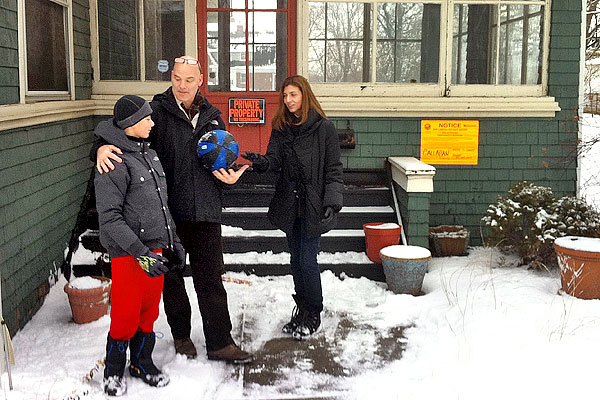Last August, David McClain and Sanaa Hachem paid $475,000 for a 106-year-old house in Beverly. They knew the place was in bad condition, but they expected to spend about $175,000 and six months restoring the home. “We were excited to do this renovation,” Hachem said….

Last August, David McClain and Sanaa Hachem paid $475,000 for a 106-year-old house in Beverly. They knew the place was in bad condition, but they expected to spend about $175,000 and six months restoring the home. “We were excited to do this renovation,” Hachem said. “We thought we would be living in the house by now.”
Instead, the house today has a city-issued orange sign out front prohibiting anyone from entering. The couple said it’s too full of mold and other defects to be habitable; they have applied for a demolition permit.
Trouble is, the house is a protected landmark—part of the Longwood Drive Historic District—which means tearing it down would require city approval. In January, the Commission on Chicago Landmarks temporarily declined to issue a demolition permit and suggested that the homeowners meet informally with staff to try to resolve the situation.
Their plans in limbo, the couple and their son, Liam, now use only the separate garage (where they met me for an interview) and the nearly half-acre lot. “It’s the most expensive storage space and dog walk we could find,” Hachem joked.
The Department of Public Health also declined to call for the house’s demolition. In December, Antonio Beltran, a first deputy commissioner, said that the photos and the doctors’ reports McClain and Hachem submitted weren’t sufficient proof of a health risk. Beltran advised them to hire two independent mold specialists, who would inspect the house in the presence of a department employee; he also encouraged them to provide a letter from their son’s doctor confirming that mold is a health threat to him.
As of Tuesday, the couple had not acted on Beltran’s recommendations. McClain said that professionals they are working with advised them not to. Nor have they accepted landmarks’ advice to meet with staff; the commission will hold a hearing within 90 days and pass their final recommendation on demolition to the City Council, said Peter Strazzabosco, deputy commissioner and spokesperson for the department of housing and economic development.
Both lifelong Beverly-area residents, the homeowners said that they bought the house after walking around inside for only a half-hour. They didn’t use a home inspector, McClain said, because “we knew anything the inspector looked at, we’d be replacing anyway.” Their vision, added Hachem, an interior designer who works largely for homebuilders, was to “absolutely keep the original, front part of the house and to build [onto] the back.”
After their purchase closed in August, the couple started scrubbing away built-up dust and crud while making plans with their architect, Michael Messerle, for the larger-scale renovation work. But when they spent time in the house, they said, they often ended up with headaches and ear and sinus problems. They said that they soon learned that the house was infested with aspergillus, a black mold that proliferated when they exposed it to fresh air by opening long-sealed windows.
“See the black on the window frames?” McClain said as we stood in front of the house. “That’s not dirt, it’s mold, and that wasn’t there two months ago. It’s growing.” (I could not enter the house; see the interior photos below, provided by the homeowners.)
They said that experts have told them aspergillus is so aggressive that the only effective abatement is complete removal of all affected materials—which essentially amounts to demolition. “We’ve been told we should even dig out and get rid of the soil six feet out around the foundation and six feet underneath it,” Hachem said.
As the Beverly Review reported last month, the couple’s turn from restoration to demolition sparked some ire in the neighborhood, with some suggesting that the mold claim is a ruse and that McClain and Hachem bought the house intending to tear it down and possibly split the big lot in two.
“It was always our intention to move into the house,” Hachem countered. “We did not want to tear it down until we found out we had to.” As for splitting the site, she said that “the lot is why we wanted this house. I grew up on an acre [nearby], and we wanted our son and his friends to have this to play on. We’re going to build gardens.” The couple also said that a title search prior to their purchase called up no mention that the house is protected by landmark status.
Strazzabosco would not predict whether landmarks will allow or deny demolition, but said that if the couple doesn’t meet with staff, the hearing may come down to “whether the house is a contributing structure in a landmark district, which it is.”
But, Hachem said, “if you don’t let us get rid of all this mold, then it’s going to be the next person’s problem. This house cannot be lived in.”


